 Hans Wurm’s Ringbuch c.
1507 Hans Wurm’s Ringbuch c.
1507
- A Translation
and Commentary
By
Keith P. Myers
Exclusively for the ARMA, March 2002
Introduction
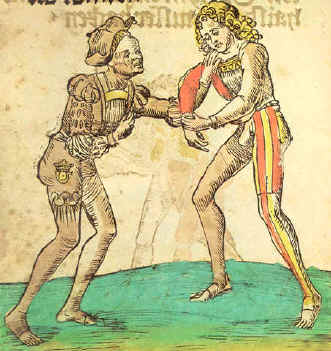 The manuscript you see here is thought to have originated in approximately 1500
in the workshop of the Landshut woodcutter and printer Hans Wurm. “Landshut” could be translated as
“grounds keeper”, which may go along with the description of Wurm as a
“woodcutter” as well as a printer. Dr.
Sydney Anglo, senior ARMA advisor and leading scholar of historical fencing, describes
Wurm’s work as an “experimental and rudimentary block book”, and notes that
it may have been one of the earliest printed treatises produced. The author remains anonymous, and only one copy is
known to survive. It is thought to consist of
the actual colored test prints made from the original wood blocks. It is unclear whether the Ringbuch was ever
actually widely published. It was, however,
plagiarized on at least two occasions. These
later reproductions referred to the manuscript as “Das Landshuter Ringerbuch.” Although they demonstrate some dialect
differences, these copies almost directly correlate with Wurm’s Ringbuch. Both likely arose independently of each other, and
where based directly upon Wurm’s earlier work. The manuscript you see here is thought to have originated in approximately 1500
in the workshop of the Landshut woodcutter and printer Hans Wurm. “Landshut” could be translated as
“grounds keeper”, which may go along with the description of Wurm as a
“woodcutter” as well as a printer. Dr.
Sydney Anglo, senior ARMA advisor and leading scholar of historical fencing, describes
Wurm’s work as an “experimental and rudimentary block book”, and notes that
it may have been one of the earliest printed treatises produced. The author remains anonymous, and only one copy is
known to survive. It is thought to consist of
the actual colored test prints made from the original wood blocks. It is unclear whether the Ringbuch was ever
actually widely published. It was, however,
plagiarized on at least two occasions. These
later reproductions referred to the manuscript as “Das Landshuter Ringerbuch.” Although they demonstrate some dialect
differences, these copies almost directly correlate with Wurm’s Ringbuch. Both likely arose independently of each other, and
where based directly upon Wurm’s earlier work.
The first copy is dated to approximately 1507.
It does not designate the exact year, the author, the printer, or the locale. While it places the techniques in the same order
as Wurm, the grapplers in the illustrations are dressed in a completely different fashion
than in Wurm’s Ringbuch.
The second copy is dated to approximately 1510.
It originated from the Augsberg printer Hannsen Sittich. Like the others, it does not list an author’s
name. It places the techniques in a
completely different order than Wurm, though the grapplers’ clothing matches more
closely. Additionally, it shows only 21 of
Wurm’s original 22 plates.
The style of wrestling or grappling illustrated in Hans Wurm’s Ringbuch is of
the same school or tradition as that found in the later work of Fabian von Auerswald. It is based upon, but differs from the unarmed combat methods that were utilized on the
battlefield 50 to 100 years earlier. This style of grappling represents a more
“sportive” version of the method. “Ringen”
is a general term that translates as “wrestling” or “grappling.” “Kampfringen” or
“Ringkampf” are terms that are often found in reference to the earlier
battlefield grappling system. These
terms translate as “combative grappling”, or “combat wrestling.” This method included arm-locks, joint
breaks, and throws designed to seriously injure the opponent. It is said to have originated with Meister Ott in the early 15th century. “Ringkunst” is the term often
applied to the more “sportive” version of wrestling that is seen in both Hans
Wurm and Fabian von Auerswald. It
translates as “grappling skill” or “art of wrestling.” In this method, no joint breaks are found, few
arm-locks are used, and the throws are modified to minimize injury to the opponent. The development of the battlefield method of
“Kampfringen” into the sportive method of “Ringkunst” parallels the
similar evolution of the Japanese battlefield Jiu Jitsu methods into the sport of Judo. The legacy of this 16th century
wrestling method can be seen continuing on today in several of the modern European folk
wrestling styles such as “Schwingen”
or “Swiss Wrestling.”
Hans Wurm’s Ringbuch follows a simple pattern.
The text typically describes the set-up that has led to the technique in the
accompanying illustration. It then continues with the phrase “so use this
technique.” It concludes with the phrase
“it is called”, and then names the technique illustrated. The names used often do not translate well,
and so are left in their original form with a translation only suggested. It must also be realized that common
everyday words would often be used to name a technique.
The literal translation of the word may not match the new meaning assigned
to it, or may be figurative only and thus not help us much in understanding the technique
itself.
Translation
of the Text
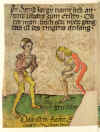 Plate 1: Plate 1:
In Saint George’s name commence, and show to the first, over the opponent.
High or low movements, this is how the wrestling begins. |
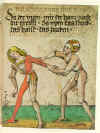 Plate 2: Plate 2:
Thus the opponent, with the hand following after, seizes you. So use this technique, that is called the Zucken (draw or jerk). |
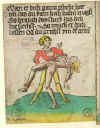 Plate 3: Plate 3:
Then he has lifted you completely and has made you come against your will. So use the technique that you see here. Thus he must let go of you or you break his arm. |
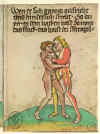 Plate 4: Plate 4:
When he holds himself completely erect and braces from behind, thus you have him in
the Hacken (Leg Hook). So use this technique, that is called the Sthragft
. |
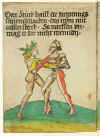 Plate 5: Plate 5:
This technique is called the inside Sthlerickhacken. Use it with all of your strength. Thus you will throw him, and he can do nothing to you on the inside. |
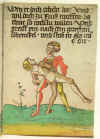 Plate 6: Plate 6:
When he has lifted you up and will throw you to your back. So insuring that you must fall. Grab
him behind the foremost thigh, and stick fast to him such that he comes to you. |
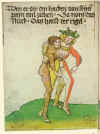 Plate 7: Plate 7:
When he will pull your Hacken from his leg. Thus
use this technique. It is called the Rigel
(bar or barrier). |
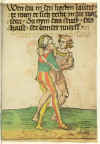 Plate 8: Plate 8:
When you have him positioned in the Hacken, and he himself is properly set in the
Wag (balanced stance). Thus use this
technique, it is called the Hinder Wurff (rearward throw).
|
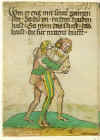 Plate 9: Plate 9:
When he stands in close with his legs, so you have him in the Hacken. Thus use this technique, this is called the Fur
Trettent Hufft (for stepping hip throw). |
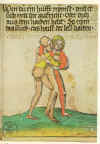 Plate 10: Plate 10:
When you have taken a hip, and he holds himself upright with you, or pulled out of
your Hacken. Thus use this technique, it is
called the Lest Hacken (freeing leg hook). |
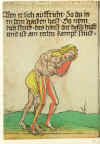 Plate 11: Plate 11:
When he holds himself upright, so that you have him in the Hacken. Thus use this technique, it is called the Halb
Huft (half hip) and is a proper combat technique. |
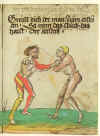 Plate 12: Plate 12:
The opponent grabs you first. Thus use
this technique, it is called the Abstok (pinning down). |
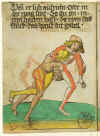 Plate 13: Plate 13:
When he himself is upright, or he is set in the Wag.
Thus you have him in the Hacken. So
use this technique, it is called the Gabel (fork). |
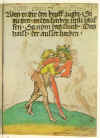 Plate 14: Plate 14:
When he pulls your body. Thus
you will pass him in the Hacken. So use this
technique, it is called the Ausser Hacken (outside leg hook). |
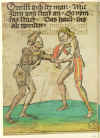 Plate 15: Plate 15:
The opponent grabs you with wrath and strength.
Thus use this technique, it is called the Abwinden (winding around). |
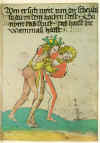 Plate 16: Plate 16:
When he is wide from your thigh, so
you stand in the Hacken. Thus use this
technique, it is called the Wammak Hufft ( jacket hip throw). |
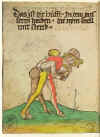 Plate 17: Plate 17:
This is the Hufft (hip throw). While
doing the Hacken at a distance, use it quickly and with strength. |
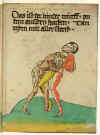 Plate 18: Plate 18:
This is the Hinder Wurff (rearward throw), while doing the Aussern Hacken (outside
leg hook). Use it with all of your strength. |
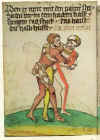 Plate 19: Plate 19:
When he intends to stand with the leg, so that you have him in the Hacken. So use this technique, it is called the Halb
Hufft (half hip). |
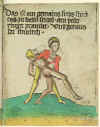 Plate 20: Plate 20:
This is a common independant technique that applies to both sides, and that every
wrestler uses. And it proceeds out of the
Thwirch (horizontal stance). |
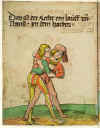 Plate 21: Plate 21:
This is the proper entry and stance in the Hacken. |
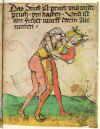 Plate 22: Plate 22:
This technique is a counter to the counter in the Hacken. And is an unconstrained throw therein to take. |
Commentary
Starting at
the Beginning:
Plate 1 shows two Wrestlers ready to “get it on.” Hans Wurm’s Ringbuch, like several
other wrestling texts in the Ringen tradition, begins with an illustration showing two grapplers ready to engage. Also, like other wrestling texts, he
includes the phrase “this is how the wrestling begins.” Some of the words on this plate are difficult to
translate, and the text at the bottom of the plate is incomplete. The text seems to begin with “In Saint
George’s name commence.” Rainer
Welle has concluded that the author of Hans Wurm’s Ringbuch was affiliated with one
of two “brotherhoods.” He notes
that these brotherhoods are first mentioned in the 1443 edition of Hans Talhoffer’s
Fechtbuch. One is noted as “zum ersten
unnser frawen bruder”, which would roughly translate as the “brothers of Our
Lady.” Their symbol was a picture of the
Virgin Mary holding the baby Jesus and wearing a crown on her head. The other is described as “sant Jorgen
bruder”, which translates as “brothers of Saint George.” Their symbol was a picture of Saint George bearing
a banner with a cross on it. In
Talhoffers’s Fechtbuch fighters are divided into these two groupings and then an
elaborate system is utilized to determine exactly when a duel should be conducted, predict
who will win, and even predict what injuries will be received. Several astrological charts are even
provided for reference. Welle notes
the opening phrase of Plate 1 of Wurm’s Ringbuch, as well as the symbolism found on
the costumes of some of the grapplers as evidence of this connection. Plate 15 shows a grappler that has a crown
above the letter “U” on his hip.
According to Welle, this represents the brotherhood of the Our
Lady. Similarly, in one of the plagiarized copies of Wurm’s Ringbuch mentioned in the
introduction, a plate shows a grappler with a cross on his hip. This is said to represent the brotherhood of Saint
George. While the validity of these
conclusions may be in question, in does help to explain the opening line of Hans
Wurm’s Ringbuch.
The text also seems to advise one to
initiate the action, by going either high (attacking above the waist) or low (attacking
below the waist) at the opponent. Both
grapplers are in a neutral crouching stance known as the “Wag.” An almost identical illustration is found at
the beginning of the grappling section of the Goliath Fechtbuch. A similar illustration is also found at the
beginning of Fabian von Auerwald’s Ringbuch, though the grapplers are shown standing
almost upright rather than in a crouching position.
Stances:
The stance known simply as “Wag”, which translates as “weighing
scale” or “balance” is mentioned in Plates 8 &13. In modern terms it is referred to as the
“balanced stance”, in the sense of standing in a well-balanced position with the
weight equally distributed between both legs. Neither
of the plates in which the stance is mentioned actually illustrate it in use, but it can
be seen in Plate 1. The “Wag”
or “balanced stance” is also mentioned in Ott’s Ringbuch, the grappling
section of the Codex Wallerstein, as well as in Fabian von Auerswald’s Ringbuch. It was a commonly used basic stance in the
German Ringen tradition, and is roughly equivalent to the “horse stance” used in
many Asian martial arts. It is assumed
by standing with the feet shoulder width or slightly wider, with the feet parallel to each
other and the knees bent in a crouching position. The
weight should be spread equally over both feet, and the hands held low.
The stance referred to as “Thwirch”,
which translates as “across” or “horizontal”, is mentioned in
Plate 20. As with the “Wag”,
it is a common basic position in the German Ringen traditions and is mentioned in numerous
other works. In modern terms it is
referred to as the “horizontal stance”, and is roughly equivalent to the
“bow stance” used in many Asian martial arts.
It is assumed by standing with one foot forward, with the lead knee bent and the
rear knee nearly straight. The majority of
the weight is carried over the lead foot. Since
this translates as “across”, a more dynamic action is suggested. It may be that what is actually being referred to
is the shifting of the weight from a balanced position in the “Wag” to having
the majority of it over the lead leg as you step forward.
This shifting of weight “across” provides momentum and leverage
for many of the unbalancing moves used in Ringen.
The Hip
Throw:
This technique is common to grappling systems the world over. It is referred to in Ringen simply as the
“Hufft” or “hip.” It
is featured in different variations in Plates 9, 16, & 17. The hip throw involves grabbing the opponent
around his upper body in some fashion as you pivot away from him, lift at least some of
his body weight up onto your hip and lower back, and then bend sharply forward to throw
him onto the ground in front of you. Plate
9 illustrates a “stepping hip throw”, which involves stepping in front of the
opponent’s outside leg with your own to create a barrier to assist in the technique. While it is not described, a simple variation is
to kick back with this leg in order to sweep the opponent’s base out from under him
as you do the throw. This would convert
a “stepping hip throw” into a “sweeping throw.” Plate 16 illustrates a “wammak”
hip throw. “Wams” translates as
“jacket” or “doublet.” The
only difference between the hip throws illustrated in Plates 9 & 16 is that the latter
seems to show the thrower grabbing his opponent near the waistline in order to assist his
technique. Therefore a “wammak
hufft” would appear to be a hip throw assisted by grabbing hold of the
opponent’s jacket. Plate 17
confuses the issue a bit. It refers to
the hip throw illustrated with only the general term “Hufft”, and actually more
clearly shows the thrower grabbing his opponent at the waistband than does Plate 16. But unlike Plates 9 & 16, the thrower in Plate
17 has reached in front of his opponent’s head rather than around his neck. This makes lifting the opponent up onto the hip
much more difficult, and produces a technique that is actually more of a
“takedown” than a “throw.”
The Half
Hip:
This technique is illustrated in Plates 11 & 19.
In Plate 11 it is nearly indistinguishable from the hip throw illustrated in Plates
9 & 16. A
little clue to its execution is provided in Plate 19, which shows the thrower with his leg
between his opponent’s legs rather than in front of his outside leg. But if these plates from Hans Wurm were all
we had to go on, we would never be able to figure out what is actually intended. Fortunately, Fabian von Auerswald also features
this technique in his Ringbuch of 1539. He
uses two plates to illustrate both the set-up and follow-through for the “half
hip” technique. This begins like a
hip throw, but rather than lifting some of the opponent’s body weight onto your hip
and lower back, you allow him to slide off of your hip to the outside. As he slides off of your hip, you pull him
across by his outside shoulder so that he spins and lands flat on his back. This is a bit safer than using the hip throw
to land the opponent on his head, and is in keeping with the more “sportive”
emphasis of the later Ringkunst method. But
it is interesting to note that in Plate 11 of Hans Wurm’s Ringbuch the author makes a
point of saying that the “Halb Hufft” is a “proper combat technique.” Perhaps this was in reaction to accusations
that the technique had been “watered down” for sportive purposes?
The
“Zucken”:
This technique is illustrated in Plate 2.
“Zucken” translates as a “short and quick movement” such as a
“jerk or twitch.” It figures
prominently in Meister Ott’s Ringbuch, though he never gives the technique a name. As in Wurm’s Ringbuch, Ott describes the
“Zucken” as being used in several different circumstances as a way to counter
and off-balance an opponent who has grabbed you at the arm in some way. You simply reach across, grab his hand at the
wrist with your same hand (left hand to his left hand or vice versa), and then pull his
arm across in front of his body as you press against the back of his elbow with your other
hand to unbalance him. As the name
implies, this should be done quickly and explosively in order to break the opponent’s
balance and set him up for a counter.
The
“Abwinden”:
This is a basic technique that is illustrated in Plate 15. “Abwinden” can be translated as
“winding around.” The
opponent has grabbed you with “wrath and strength.” Pass your arm over his and grab your own wrist
with your opposite hand. Pivot inward as you
pull inward with both arms against his forearm near the wrist to break his hold. Fabian von Auerswald names the same
technique, but shows it as passing your arm under the opponent’s from the outside
rather than over the top. Either way,
you are “winding” your arm around his, and turning the opponent to break his
balance.
The
“Abstok”:
This is a basic technique that is illustrated in Plate 12. “Abstok” can be loosely translated as
“pinning down.” This technique is
also illustrated in Fabian von Auerswald’s Ringbuch, and described in Meister
Ott’s Ringbuch, though neither gives it a name.
When the opponent has grabbed you at the shoulder or lapel, simply trap his hand
against you by pressing with both of your own against his to force him to bend at the
wrist as you take a step back. This
will unbalance him and set him up for a subsequent technique. Fabian von Auerswald illustrates it as a set
up leading to a Back Lever Takedown.
The
“Hacken”:
15 out of the 22 plates that make up Hans Wurm’s Ringbuch feature the
“Hacken” in some way. Similarly,
at least 15 out of the 85 plates in Fabian von Auerswald’s Ringbuch deal with the
“Hacken.” The Hacken is the Ringen
equivalent of the modern wrestling “grapevine” technique. It involves wrapping one of your legs around the
leg of the opponent to trap him, to unbalance him, or to assist a takedown. While it is a prominent feature of the Ringkunst
method, it is seen far less frequently in the older Kampfringen system. This may be because by entangling yourself
with the opponent, you greatly increase the chances that you will go to the ground with
him if he falls. On the battlefield
this was something to be avoided whenever possible.
In the more sportive environment of the latter Ringkunst system, falling to the
ground with the opponent would not be as problematic.
You typically would not have to worry about your opponent’s comrades attacking
you while you are on the ground and vulnerable.
The role of ground-fighting in the Ringen traditions deserves comment here as well. It is interesting to note that while the
earlier
Kampfringen method used the Hacken only sparingly, it does include some ground-fighting
techniques. But the later
Ringkunst method, which makes much more frequent use of the Hacken and therefore would
seem to end up on the ground more often, includes no ground-fighting techniques at all.
Plate 21, despite the fact that it is the next to the last plate in Wurm’s
Ringbuch, lays the foundation by showing “the
proper entry and stance in the Hacken.” It
illustrates one grappler wrapping his leg around his opponent’s from the inside and
front so that they cross at the ankle. Plate
10 illustrates the “Lest Hacken.” “Lest”
can be translated as “freeing.” The
plate shows the Hacken used as a counter or recovery when your previous technique has been
foiled. Therefore the term “freeing
Hacken” may refer to the Hacken used when someone has “freed” himself from
you. Plates 8, 14, & 18 show the “Aussern Hacken” or
“outside” Hacken. This involves
wrapping your leg around the opponent’s from the outside and behind. It should be noted that in each of these plates it
is the grappler on your left who is performing the technique. In Plate 14, the grappler has performed a
“durchlauffen” or “pass through” to move behind his opponent before
putting him in the Hacken. Plate 17
mentions a “Serm Hacken.” It is
unclear at this time how this would translate.
The only significant difference between the technique illustrated on
this plate versus the “standard” Hacken shown on Plates 9, 11, 16, & 22 is
that it is seems to be performed on the opponent’s rear leg rather than his lead leg. Plate 5 mentions a “Sthlerick
Hacken.” Again, it is unclear at this
time how this should be translated. In
this case, the Hacken is applied while facing towards the opponent rather than pivoting
away.
Several counters and follow-ups to the Hacken are also shown in Wurm’s
Ringbuch. Plate 13 illustrates the
“Gabel” or “fork.” This
technique is also shown in Fabian von Auerswald’s Ringbuch. After performing the Hacken to unbalance the
opponent, kick your leg up and back in the “fork” of his legs to perform a
sweeping throw. Plate 7
describes the “Rigel”, or “bar” or “barrier.” This is a follow-up to be used against
someone who has grabbed your leg in order to dislodge your Hacken. The actual technique is unclear in Wurm’s
illustration. Fortunately, this is
another case in which we can refer to Fabian von Auerswald for help. The “Rigel” is actually very
similar to the “Gabel.” You throw
the opponent forward while creating a “barrier” with your leg by leaving it
planted on the ground rather than kicking it up and back as in the “Gabel.” Plate 22 is showing a “counter to the
counter” when you have applied the Hacken. It
appears that the opponent has attempted to counter the Hacken by pressing into his
opponent’s neck with both arms. His
opponent responds by converting his Hacken into a “Hufft” or hip throw. Plate 4 shows another follow-up from
the Hacken that is called the “Sthragft.” It
is unclear at this time how this should be translated and exactly what technique is
intended in the illustration.
The
“Rearward Throw”:
Plates 8 & 18 illustrate the “Hinder Wurff” or “Rearward
Throw.” Both include the use of
the “Aussern Hacken” to set up the technique.
After unbalancing the opponent with the Hacken, force him over to the rear so that
he falls on his back. Plate 18
illustrates this much more clearly than Plate 8.
Plate 8 could be interpreted as using the “Hinder Wurff” to counter the
opponent’s attempted hip throw or “Half Hip” technique. In this instance, the grappler on the left
would be performing the techniques.
Miscellaneous
Counter Techniques:
Plate 3 illustrates a very nice “Radt.”
This translates as “wheeling” throw, though I have also referred to it as
a “Rear Scooping Throw” in another work. The
name comes from Fabian von Auerswald. However, in Wurm’s Ringbuch what is actually
being shown is the counter to this throw. Wurm
says “he must let go of you or you break his arm.” As the opponent throws you backward, hook your arm
into the bend of his arm and drag him down with you.
Either he lets go, falls forward onto his head, or suffers damage to
his elbow or shoulder. Unfortunately,
if he does just “let go” as noted in Wurm’s text, you still fall to the
ground and he remains uninjured. Plate
6 illustrates a very nice “Front Scooping Throw.” Again, Wurm’s Ringbuch is showing the
counter to this technique. In this case
he advises that one should grab onto the opponent’s leg (its also a good idea to grab
his waist at the same time) to both slow your fall and drag the opponent down with you. Plate 20 shows what appears to be a counter
to the “pass through.” As your
opponent attempts to go under your arm to get your back, pivot and shift into the
“Thwirch” or horizontal stance as you drop your arm onto the back of the
opponent’s neck and lift his leg to throw him.
Conclusion:
In the Ringkunst tradition, Fabian von Auerswald’s Ringbuch of 1539 provides
more coverage, more extensive text with better explanations, and clearer illustrations
than Hans Wurm’s Ringbuch. But “Das
Landshuter Ringerbuch” has an important place in history as being possibly the first
printed work in this area. Additionally, Wurm
provides terminology for specific techniques that is not found elsewhere, and provides us
with a better understanding of which techniques were commonly in use. It is an important work to study for anyone
interested in the German Ringen methods.
Glossary
of Terms:
Ringen: Wrestling or Grappling
Ringbuch: Wrestling/Grappling Manual
Fechtbuch: Fight/Fencing Manual
Hacken: The “leg hook”. It is the equivalent of the “grapevine”
technique seen in modern wrestling.
Aussern
Hacken: The “outside leg hook.”
Lest Hacken: The “freeing leg hook.”
Serm Hacken: (?) leg hook
Hufft: The “hip throw”
Halb Hufft: The “half hip throw”
Fur Trettent
Hufft: The “stepping hip throw.”
Wammak
Hufft: jacket hip throw
Hinder
Wurff: The “rearward throw.”
Radt: “wheeling” throw or rear scooping throw
Rigel or
Riegel: The “bar” or
“barrier”, from forming a barrier with your leg
Wag or Wage: The “balanced stance”.
Thwirch or
Zwerch: The “horizontal
stance”
Zucken: The “jerk” or “twitch.” Used to break the opponent’s balance when he
has grabbed you.
Abstok: “Pinning down.”
Gabel: The “fork” A sweeping throw possibly referred to by this name
because you are lifting within the “fork” of his legs
Abwinden: “Winding around.”
References:
1.
The Martial Arts of Renaissance Europe.
By Sydney Anglo, Yale
University Press, 2000
2.
“…und wisse das alle
hobischeit kompt von deme ringen: Der
Ringkampf als adelige Kunst im 15. Und 16. Jahrhundert.” By
Rainer Welle, Centaurus,
1993.
© Copyright 2002 by K. Myers. |

